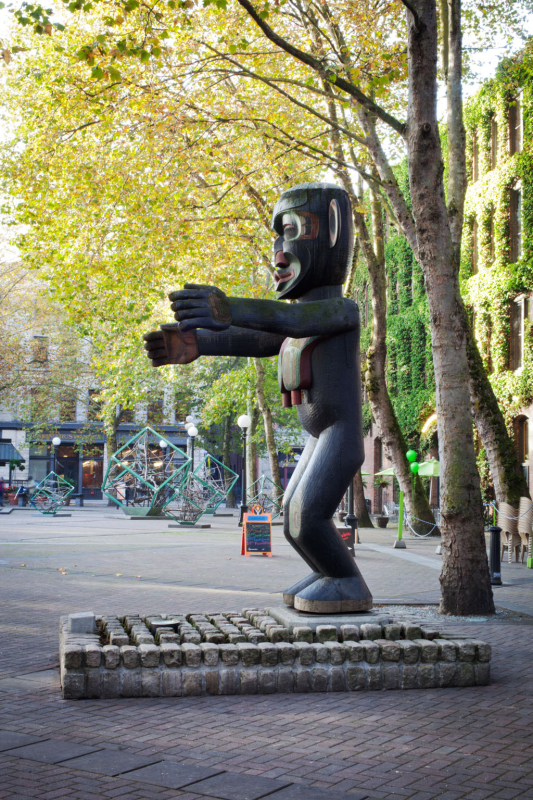Occidental Square
-
Occidental Square
This is the last stop on the walking tour, and, in a way, we are coming full circle. We began with a totem pole and are ending with a group of totem poles whose carvings were derived from indigenous designs.
In 1985, developer, gallery owner, and long-time resident of Pioneer Square Richard White (d. 2002) donated, via the Pioneer Square Association, four carved totem poles by the non-Native artist Duane Pasco (b. 1932), to the City of Seattle. Pasco created the intricately carved poles between 1971 and 1973, with one work — Sun and Raven — bound for exhibition at Expo ’74 in Spokane, another world’s fair held in Washington. He honed his trade while living in Alaska, Washington, and British Columbia. These poles originally stood at White’s Kiana Lodge, a meeting center on the Kitsap Peninsula, along with several other totem poles by Pasco. When White sold the lodge, he donated the works to the Pioneer Square Association. Pasco took them to his studio in Poulsbo to refurbish them before permanently installing them here in 1987 and 1988. Pasco’s work has been called, “some of the city’s finest examples of carving in the Northwest Coast Indian style.” What Pasco may have lacked in ancestral heritage, he made up for in skill honed through a lifetime of immersion with indigenous artists and cultures whose style he strove to emulate.
Unlike the first totem pole encountered on this tour, Seattle Totem Pole, the stories associated with these totem poles wouldn’t have come from Pasco’s own ancestors. Pasco may have derived the characters from those found in Haida, Tlingit, Kwakwaka’wakw (Kwakiutl), Tsimshian, Nuxalk (Bella Coola), Nuu-chah-nulth (Nootka), or other Northwest Coast indigenous cultures who carved works into cedar wood. The style and expertise of carving are what make these works special.
Sun and Raven (1973) by Duane Pasco
According to Pasco, the design references the indigenous legend of Raven bringing light into the world. It’s a story similar to that of the Tlingit Seattle Totem Pole seen earlier in Pioneer Place Park. At the pole’s base is the sun being held above the box in which it had been stored before Raven stole it. The story culminates at the top with Raven spreading sunlight to the world.
Killer Whale (1971) by Duane Pasco
Killer Whale (also called Man Riding on Tale of Whale) features a whale with a man riding on its tail and a single dorsal fin prominently extending from its center. In Native cultures the killer whale is known as the guardian of the sea and is considered supernatural. It symbolizes family, communication, and longevity, and is known for protecting travelers and guiding them home. Like the orcas who inhabit nearby Puget Sound and live and travel together in pods, whales in Native cultures symbolize a strong connection to harmony and community.
The next two works are just to the left and closer to S Washington Street. The two works face each other.
Bear(1973) by Duane Pasco
In Northwest Coast indigenous cultures, the bear symbolizes strength and courage, family, and teaching, and is known as the animal kingdom’s protector. The bear possesses human-like qualities and is considered thoughtful and independent.
Tsonqua (1973) by Duane Pasco
Tsonqua (also called Tsonoqua, Tsonokwa, Dzunuk’wa, and other names) is often the “Wild Woman of the Woods.” She is a giant that roams the forest and is both revered and feared. She is considered a bringer of wealth, food, and good fortune. However, she also searches our disobedient children who have wandered too far from home. In Kwakwaka’wakw (Kwakiutl) stories, for example, she steals the children, puts them in a basket, and carries them to her home with the intent of eating them. However, she is clumsy and slow, and the children usually outsmart her and escape. She is characterized by her pendulous breasts, recessed eyes, and hollow cheeks. She is often depicted with pursed lips and cries out, “Hoo! Hoo!” Tsonqua is invoked by exasperated mothers to frighten their children into obedience.






